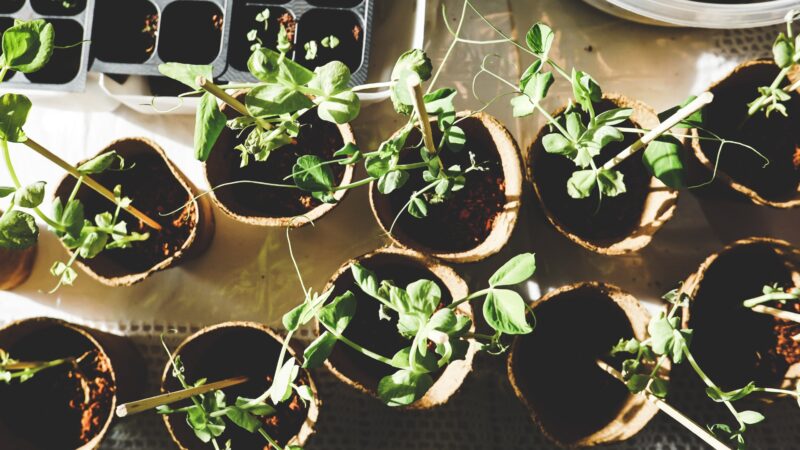Sufficient amounts of phosphorus in soil are essential for the optimal growth of plants and what better way is there to provide your soil with the phosphorus content it needs than applying phosphorus-rich fertilizers!
Fertilizer that is high in phosphorus are bat guano, blood meal, bone meal, burned cucumber skins, compost, cottonseed meal, enriched rock phosphate, fish meal, manure, and worm castings.
This article will provide you with everything you need to know about phosphorus fertilizers, how to apply them, and other interesting information. Read further for more!
Do Plants Need Fertilizer With Phosphorus?

Plants do need fertilizer with phosphorus, as it is an essential nutrient that can aid in plant growth and increase yields. If you want your plants to reach maturity faster, fertilizers with phosphorus will do the trick.
Why Is Phosphorus Used in Fertilizers?

Phosphorus works by catching, storing, and then converting heat energy from the sun into biomolecules that drive biochemical reactions, such as photosynthesis, starting from the germination of the plant and throughout its maturity. As such, phosphorus improves winter hardiness, early root development, water-use efficiency, and seed formation.
Common Symptoms of Phosphorus Deficiency in Plants

- Dark green or unusual purpling of leaves, particularly found on its veins and undersides, as well as curling, distorting, or stunted growth.
- Older leaves can develop tip dieback while younger leaves can drop prematurely.
- Increased root growth and reduced shoot growth. Roots can also appear smaller than usual.
Can You Have Too Much Phosphorus in Soil?

Plants can grow poorly and, in worst-case scenarios, die if there are excess amounts of phosphorus in the soil.
When to Apply Phosphorus Fertilizer?
Apply phosphorus fertilizer when the results of your soil test indicate you do so or if you see symptoms of your soil being deficient in phosphorus. This is usually done during the spring season, but it can also be applied in fall and winter depending on when you plant crops.
What Fertilizer Is High In Phosphorus?
Bat Guano
This type of natural fertilizer is extracted from the pellet-formed excrement of bats from disintegrating cave walls. Workers will shovel the guano into an air compressor which sucks the material into large bags.
Rock particles that have been mixed with it are sifted out while heavy fertilizer salts are added since dry bat guano is dusty and much too light for distribution.
Bat guano is considered a nitrogenous fertilizer as it mainly provides supplemental nitrogen, however, it also contains a considerable amount of phosphorus. To be exact, its NPK analysis is 8-5-1.5. The older layers of bat guano in a cave have higher amounts of phosphorus. In fact, it can reach up to 10% if mined deeply.
Blood Meal
A blood meal is a by-product of the meat industry, specifically consisting of dried slaughterhouse waste or when dried animal blood is grinded into a meal. It has a powdery or granular texture and is dark brown to dull red in color. It is an organic fertilizer but is economically used as feedstuff for livestock animals since it is a good source of ruminant bypass protein.
This fertilizer primarily contains readily available nitrogen, iron, and trace minerals but it also has about 1% phosphorus. Its NPK analysis is usually 12-0-0, but can also be 13.25-1-0.6. A blood meal is commercially bought from feed stores but is generally expensive when purchased from garden centers.
Bone Meal
This fertilizer is produced from defatted, dried animal bones that are grinded into a fine powder. It can be used both as an organic fertilizer and animal feed as it works as a mineral supplement. There is also a steamed variant where animal bones are steamed under pressure before they are grinded and dried.
Bone meal is a well-known source of slow-release phosphorus, calcium, and trace elements. Its usual NPK analysis is 3-15-0 but, depending on the brand, it can have as high as 20% phosphorus content. Products purchased from feed stores have higher amounts of phosphate, about 2.3 times more than those bought at garden centers.
Burned Cucumber Skins
As the name suggests, burned cucumber skins are peels of cucumbers that are roasted in a pan until they are brown. They are cut into several, tiny pieces before they are added to the soil.
It has high amounts of phosphorus and potassium at an NPK analysis of 0-11-27 and you don’t have to be wary of excess fertilization since it can also work as compost.
Additionally, cucumber skin ash can also be used as fertilizer. Simply dry the cucumber peels out in the sun, place them on a tray, burn them, and then collect the resulting ash.
Compost
Compost is a slow-release soil enricher, fertilizer, and buffer as it contains macro and micronutrients that are often not present in synthetic fertilizers, neutralizes soil pH levels to the optimum range, helps retain water and increases nutrient uptake, and loosens tightly-bound soil so that air can permeate better.
Generally, compost has low amounts of phosphorus compared to other fertilizers in this list. Dairy compost contains 1% phosphorus while vermicompost contains 2%. As such, it is not recommended to use compost as long-term fertilizer. Instead, it should be used as a soil amendment to improve plant nutrition.
Cottonseed Meal
Produced when flakes that remain after oil is extracted from cottonseeds are grinded into brown, black-flecked powder or granules, cottonseed meal is an excellent protein source for ruminant animals. It is also used as a slow-release, all-purpose fertilizer, particularly for acid-loving plants such as blueberries, azaleas, and roses.
Cottonseed meal has an NPK analysis of 6-0.4-1.5 or 6-2-1 and, as such, it is usually considered a nitrogen-rich fertilizer. When buying in stores, make sure to select pesticide-free cottonseed meal since pesticides are usually applied to cotton crops and remain as residue in the seeds.
Enriched Rock Phosphate
Made by combining clay particles with natural phosphate, enriched rock phosphate is the raw material used to formulate the most commercially available phosphate fertilizers. It is processed in an electric furnace but can also be created by treating it with phosphoric acid and gypsum. Currently, rock phosphate is not commonly used in agriculture now.
Enriched rock phosphate has an NPK analysis of 0-3-0, with 18% calcium content. There are also micronized variants which are usually more available than regular soft rock grind variants. This fertilizer is commercially sold under colloidal phosphate and can even serve as a soil amendment due to its micronutrient content.
Fish Meal
Fish meal is produced from almost any type of seafood but is generally made from small marine fish that are wild-caught and contain a high percentage of oil and bones. Usually, these fish are not considered suitable for human consumption and therefore industrial grade since they are caught for fish oil and fish meal production.
Typical NPK analysis of fish meal is 10-6-2, making it an excellent source of both nitrogen and phosphorus. It also contains 14% calcium.
Manure
Manure is a great fertilizer that works by adding organic matter to the soil which improves aeration, water infiltration, moisture-holding capacity, and overall structure. The nutrient content of manures depends on the source. Dried commercial products usually contain more nutrients compared to fresh manure.
Here are the approximate phosphorus analysis of manure depending on the source:
| Source | Fresh (%) | Dried (%) |
| Dairy | 0.55 | 0.9 |
| Hog | 0.55 | 2.25 |
| Horse | 0.65 | 0.7 |
| Sheep | 1 | 1.35 |
| Steer, feedlot | 0.65 | 2.05 |
| Poultry | 1.1 | 4.15 |
Worm Castings
Earthworms have specialized digestive systems that allow them to convert food waste and other organic matter to a nutrient-rich type of compost called worm castings or vermicast. Worm castings that undergo a cold composting process are referred to as vermicompost and are also used as fertilizer.
Worm castings have an NPK analysis of 5-5-3, but phosphorus content can reach up to 19.58%. Generally, worm castings are used as soil amendment instead of fertilizer since they also work as soil conditioners which loosen soil and improve water movement and aeration, as well as increase the amount of organic matter in the soil.
How to Use High Phosphorus Fertilizer?
| Phosphorus Fertilizer | Application |
| Bat Guano | Till in 5 pounds of bat guano per 100 square feet or, if used as a tea, dilute 3 teaspoons per gallon of water then spray onto plant foliage. |
| Blood Meal | Till in 5 to 10 pounds of blood meal per 100 square feet of planting area. It can also be diluted in water prior to application. |
| Bone Meal | Till in 10 pounds of bone meal per 100 square feet of planting area. You can also sprinkle it to compost. It works better if soil pH level is below 7.0 and on root crops and bulbs. |
| Burned Cucumber Skins | Add 2 cucumber skins per plant once every 3 weeks. For cucumber skin ash, sprinkle 2 teaspoons on the soil of small plants and 4 to 5 teaspoons for bigger-sized plants. |
| Compost | Work in 1 to 2 inches of compost into the upper 3 to 5-inch layer of the soil. Make sure to evenly spread it using a garden fork or other similar tools. |
| Cottonseed Meal | Apply a 1 to 2-inch layer of cottonseed meal to the desired area. If soil is extremely low on phosphorus, till in 8 to 10 pounds of cottonseed meal per 100 square feet of planting area. |
| Enriched Rock Phosphate | Incorporate 5 pounds per 100 square feet of planting area. It must be done prior to planting. For trees and transplants, apply 1 to 10 pounds per plant depending on their size. |
| Fish Meal | Till in 5 to 10 pounds of product per 100 square feet of planting area or incorporate 1 to 2 tablespoons per gallon of soil. |
| Manure | Mix manure with compost to reduce the risk of burning plants and then till into the soil one season before planting. It is usually applied during the fall season. |
| Worm Castings | Mix into the soil prior to planting or transplanting seedlings. Blend it with compost for the best results. You can also directly apply 1 square inch of worm castings onto topsoil. |
List of Sources
Organic Fertilizers – https://cmg.extension.colostate.edu/Gardennotes/234.pdf